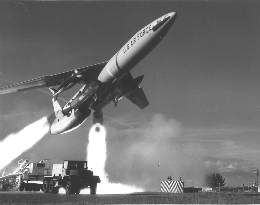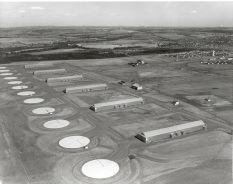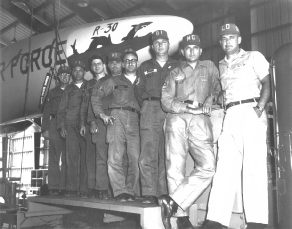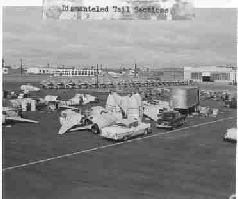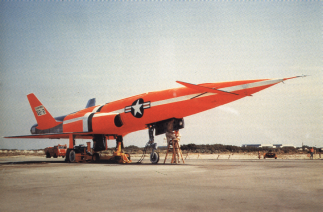Snark (SM-62) Intercontinental cruise missile, launched from a mobile launcher with two solid boosters, and powered by a Pratt and Whitney J-57. Programmed to fly at mach .9 at 45-50,000 feet for 1,500 to 5,000 miles, guided by an “automatic celestial guidance" system. Flight Tests - First successful launch 27 June 1958 from Cape Canaveral . - Many flight failures, resulting in the phrase “Snark infested waters” around the Cape. Basing - March 1957, Presque Isle AFB, Maine, selected as first Snark base. 556 SMS activated at Patrick AFB in December 1957 for Snark training and testing. In late 1958, CINCSAC General Tom Power recommended cancellation of the program because of reliability, vulnerability and accuracy problems. Deployment continued, with the 702 SMW activated at Presque Isle AFB on 1 January 1959. 556 SMS scheduled to move north, but was inactivated in July 1959. The 702SMW had no subordinate squadrons. Operation and Maintenance at Presque Isle AFB - Wing Director of Missiles operated and maintained the assigned missiles. A total of thirty were manufactured. First missile attained alert status on 18 March 1960. Wing was declared operational in February 1961. President Kennedy called the missile “obsolete and of marginal military value” and inactivated the 702 SMW on 25 June 1961. Missiles destroyed by wing personnel at Presque Isle AFB. Photos: Snark Launch, Snark Graduation from Training, Presque Isle AFB, A Snark Crew, Destroyed Missiles |
|
|
|
|
| Navaho (SM-64, WS104-A) Supersonic 5,500 mile range ramjet powered cruise missile. Launched vertically mounted on a rocket booster. First use of gimbaled rocket motors and inertial guidance Fight Testing - First tests were the X-10 drone tested in 15 flights at Edwards AFB., CA and 12 at Cape Canaveral. Powered by two Westinghouse XJ-40 turbojets with afterburners. Tests from and to runway using retractable landing gear. 3 additional tests at Cape Canaveral testing the vehicle for a drone mission. The G-26 version was powered by two XRJ-47 Ramjets and launched using a booster with two XLR-83 Liquid Rocket engines. 11 test flights conducted at Cape Canaveral with many problems during the tests. The G-38, XSM-64A was slightly larger than the G-26 test vehicles and powered by two RJ-47 Ramjets. Booster had three Rocketdyne LR-83 LOX and kerosene engines Cancellation - Continued problems combined with first Atlas success led to cancellation on 13 July 1957. AF decided to develop ballistic missiles in a 1955 decision by President Eisenhower. Program Benefits - Rocket engine design aided development of Atlas and Titan engines. X-1 inertial guidance system led to similar systems in Minuteman, the Hound Dog, submarines and other uses. The Navaho Missile Project by James N. Gibson is an excellent history of the program. |

